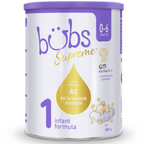Tips For Dealing With A Fussy-Eating Toddler
Parenting is a journey filled with joy and challenges, and one common hurdle many parents face is dealing with a fussy-eating toddler. The struggle of getting your little one to eat can be both frustrating and concerning. However, understanding the roots of fussy eating and employing effective strategies can transform mealtimes into a more positive experience for parents and toddlers alike.
What is fussy eating in toddlers?
Fussy eating in toddlers is a common phase characterised by the rejection of certain foods or a reluctance to try new ones. This behaviour can be attributed to various factors, including developmental changes, evolving taste preferences and starting to assert independence. Toddlers are navigating a world of new sensations, and their relationship with food is no exception. Understanding the reasons behind fussy eating is the first step in fostering healthier eating habits.
Tips for fussy-eating toddlers
Create a Positive Mealtime Environment
Fostering a positive mealtime environment is crucial when dealing with fussy-eating toddlers. Maintain a calm atmosphere during meals, avoiding pressure or stress. Family meals play a significant role in shaping a child's relationship with food, providing a sense of routine and connection. Make mealtimes enjoyable social for the whole family by eating together whenever possible, minimising distractions such as screens and focusing on positive interactions and responses to enjoying food.
Introduce Variety & Colour
Toddlers are naturally curious, and this curiosity extends to the food on their plates. Introduce a variety of foods, focusing on vibrant and visually appealing options. Incorporating colourful fruits, vegetables, and other nutritious foods can capture their interest and make mealtimes more enjoyable. Get creative with presentations to make healthy choices exciting and enticing for your fussy eater toddler. And remember, it can take up to 10 or more exposures for a toddler to accept and feel comfortable with a type of food, so keep trying!
Encourage Play & Discovery
Encouraging toddlers to engage in play and discovery during mealtime can have numerous benefits for their overall development. By allowing them to explore their food and get messy, toddlers are more likely to develop a positive relationship with eating and be more accepting of different foods. Letting them make a mess, get their hands dirty, and explore textures can stimulate their senses and make mealtime a fun and interactive experience. Avoid the urge to clean up or wipe their face until the very end of the meal, as this allows them to fully immerse themselves in the exploration process without interruptions.
Involve Your Toddlers in the Meal Preparation
Engaging toddlers in the kitchen can be a game-changer. Involving them in meal preparation empowers them and makes them more invested in the eating process. Offer age-appropriate tasks such as washing vegetables, stirring ingredients or arranging food on plates. This hands-on approach makes mealtimes fun and encourages a positive attitude toward different foods.
Establish a Consistent Routine
Consistency is key when dealing with fussy-eating toddlers. Establish a regular routine for meals and snacks, providing a sense of predictability for your toddler. Consistent mealtime schedules can reduce stress and create an environment where your little one knows what to expect. Consider incorporating rituals like setting the table together or having a pre-meal chat to make mealtimes comforting and reassuring.
Encourage Positive Eating Habits
Fostering positive eating habits involves role modelling and positive reinforcement. Demonstrate healthy eating behaviours by letting them see you enjoying a variety of foods too. Praise and positively reinforce good eating behaviours rather than focusing on what your toddler refuses. Creating a positive association with mealtimes can gradually shift their attitude towards trying new foods.
Address Textures and Sensory Preferences
Texture and sensory preferences play a significant role in fussy eating. Introduce a variety of textures gradually, allowing your toddler to become accustomed to different sensations. Be mindful of any sensory aversions and work on overcoming them patiently. Understanding and respecting your child's sensory preferences can make mealtimes more comfortable and enjoyable for a fussy-eating toddler.
What to feed a fussy-eating toddler
When it comes to feeding a fussy eater, focusing on foods and textures that resonate with them is essential. Common foods that appeal to fussy-eating toddlers include finger foods like sliced fruits and vegetables, mild-flavoured cheeses, yoghurt or puddings, whole-grain crackers or toast, and smoothies with hidden fruits or vegetables. If you’re a parent of a fussy eater toddler, check out this guide on snack ideas for fussy eaters for inspiration.
Dealing with a fussy-eating toddler can be tricky, but this phase can be navigated with patience, understanding and effective strategies. The tips provided, from creating a positive mealtime environment to addressing sensory preferences, aim to transform mealtimes into enjoyable experiences for parents and toddlers. Remember, fussiness is often a phase, and a positive and flexible approach to mealtimes can contribute to healthy eating habits in the long run. Embrace the journey, stay patient and enjoy the shared moments around the family dining table.


